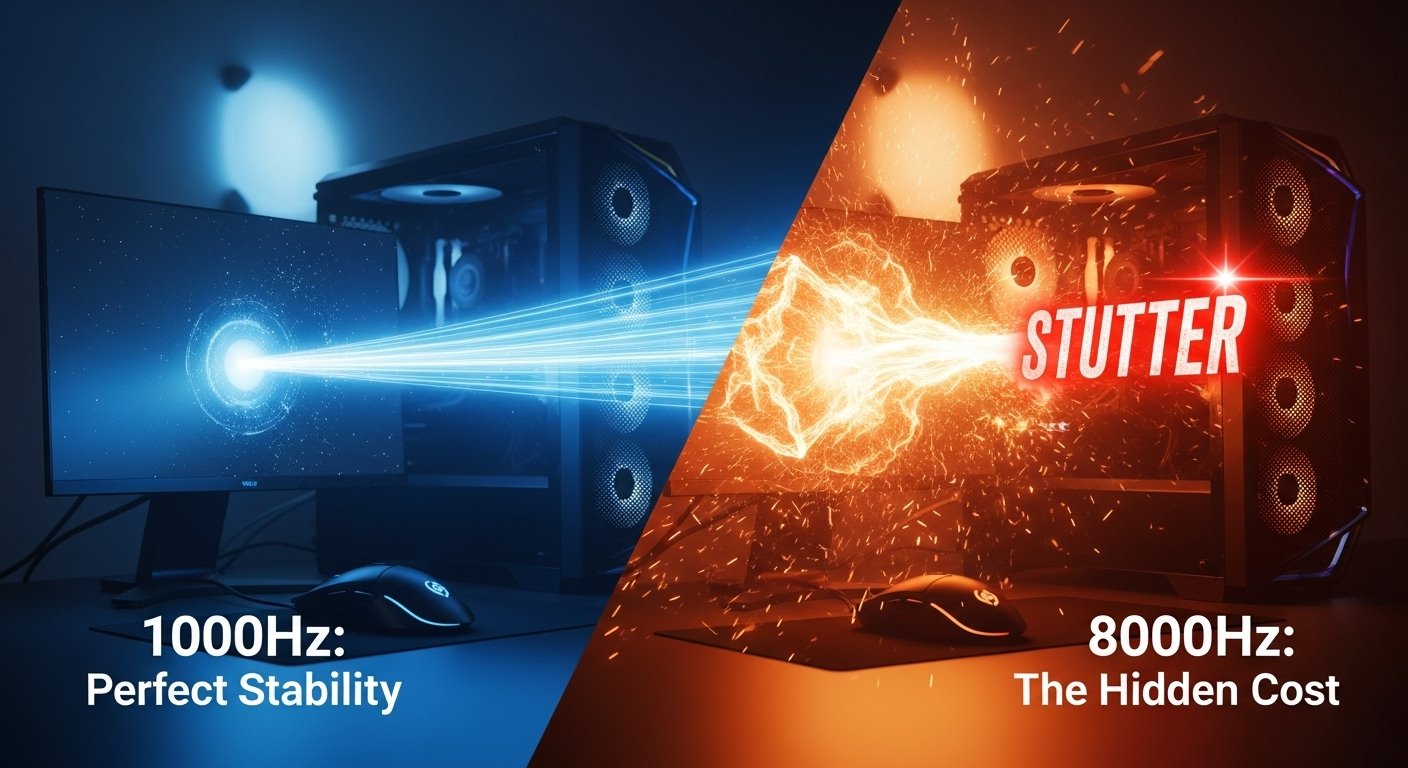You’re staring at two gaming mice on a store shelf. They look almost identical, but one box proudly advertises a standard 1000Hz polling rate, while the other screams “8000Hz!” for just a few dollars more. The marketing implies that a bigger number equals a bigger competitive advantage. But is a higher mouse polling rate always better? This question has created massive confusion, leading many gamers to believe that upgrading is a surefire way to improve their aim and responsiveness. The truth, however, is far more complex and involves a world of diminishing returns, hidden costs, and technical trade-offs that the marketing hype conveniently leaves out.
Executive Summary: Your Guide to Real-World Mouse Performance
This guide will finally cut through the noise and deliver the definitive answer on mouse polling rates. We’re going to break down what this technical specification really means for your in-game experience, from cursor smoothness to input lag. You’ll discover the hidden cost that ultra-high polling rates can impose on your computer’s CPU and why this can sometimes hurt your performance instead of helping it. Most importantly, we will explore the critical law of diminishing returns, explaining why the jump from 1000Hz to 8000Hz is often a barely perceptible difference. By the end, you’ll know the “sweet spot” polling rate that delivers the best mouse performance for over 99% of gamers, saving you money and frustration.
What is Polling Rate, Explained in Simple Terms?
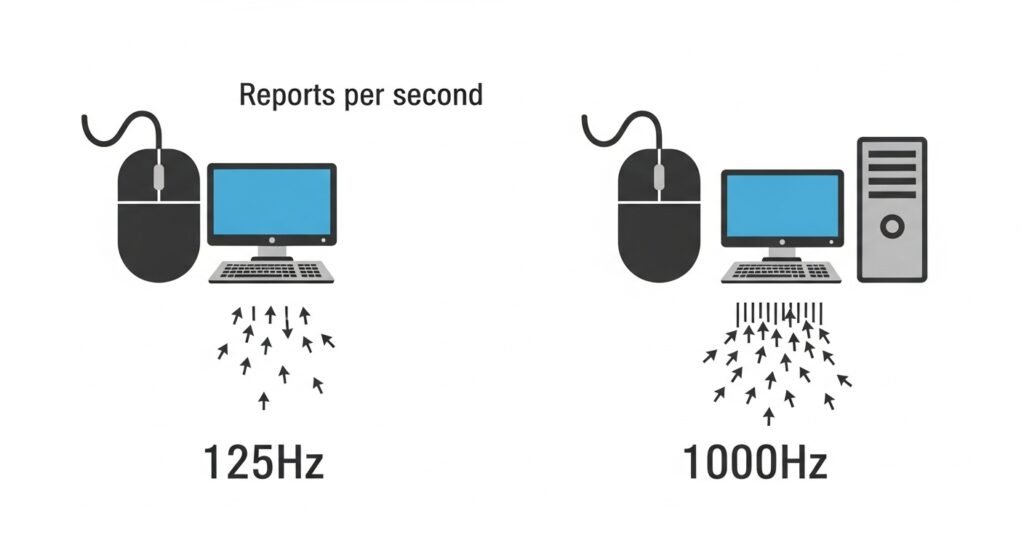
Before we can judge whether a higher number is better, we need to understand what this technical specification actually is. Simply put, the polling rate is a measure of communication. It’s how frequently your mouse reports its position to your computer. It isn’t a measure of speed or sensitivity like DPI, but a measure of responsiveness.
It’s Not Speed, It’s Communication (Reports per Second)
Think of your computer asking your mouse, “Where are you now?” The polling rate is how many times per second it asks that question. This rate is measured in Hertz (Hz).
- A 125Hz polling rate means the mouse sends a report to the computer 125 times every second.
- A 1000Hz polling rate means the mouse sends a report 1000 times every second.
- An 8000Hz polling rate means the mouse sends a whopping 8000 reports every single second.
Each report is a tiny data packet containing information about the mouse’s current position. The more frequent the reports, the more up-to-date the computer is on your mouse’s location, which leads to smoother on-screen movement. This is the foundational concept behind what a mouse polling rate is.
How Hertz (Hz) Translates to Milliseconds (ms) of Input Lag
This communication frequency has a direct impact on latency. The time between each report is called the update interval, measured in milliseconds (ms). The math is simple:
- 125Hz: 1000ms / 125 = 8ms between reports.
- 500Hz: 1000ms / 500 = 2ms between reports.
- 1000Hz: 1000ms / 1000 = 1ms between reports.
- 8000Hz: 1000ms / 8000 = 0.125ms between reports.
A lower update interval means less input lag. This is the delay between when you physically move your mouse and when the cursor reacts on screen. Reducing this delay, even by a few milliseconds, can make your aim feel significantly more direct and connected to your hand.
Why 1000Hz Became the Gold Standard for Competitive Gaming
For years, the standard for office mice was 125Hz (8ms). When gaming mouse companies made the leap to 1000Hz (1ms), the difference was massive and immediately noticeable. Shaving 7ms off the system latency was a revolutionary improvement in responsiveness.
This is why 1000Hz became the gold standard for esports and competitive gaming. It offered a huge performance boost over older technology and was easily handled by modern computers. It hit a perfect sweet spot of maximum performance for minimal cost, a balance that, as we’ll soon see, is hard to beat.
The Point of Diminishing Returns: 1000Hz vs. 8000Hz
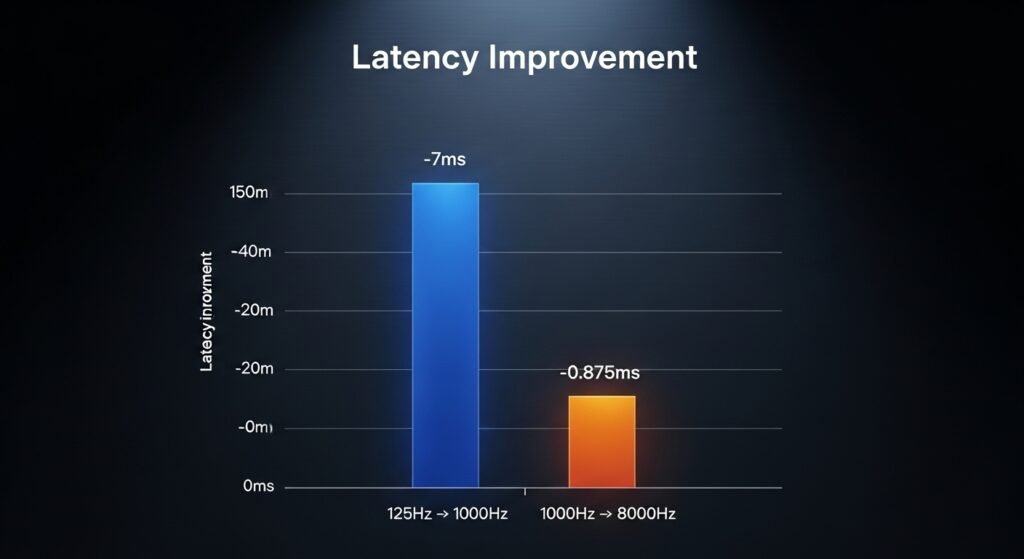
This is the most important concept in the entire polling rate debate. The reason a higher number isn’t automatically better is because of the law of diminishing returns. The performance benefit you gain from each increase gets smaller and smaller, until it becomes practically non-existent for the vast majority of people.
The Giant Leap: Why Going from 125Hz to 1000Hz Feels So Good (8ms vs. 1ms)
As we established, 1000Hz became the gold standard for a reason. When you upgrade from an old 125Hz office mouse to a 1000Hz gaming mouse, you are cutting the input lag from 8ms down to just 1ms.
You are eliminating 7 full milliseconds of delay.
This is a massive, immediately perceptible difference. Your cursor feels incredibly connected to your hand. Your tracking accuracy improves, and flicking feels instantaneous. This is a real, tangible competitive advantage that you can feel in every single movement. It’s a true night-and-day upgrade.
The Tiny Step: Why 1000Hz to 8000Hz is Barely Perceptible (1ms vs. 0.125ms)
Now, let’s look at the jump from the 1000Hz gold standard to the new frontier of 8000Hz.
- At 1000Hz, your update interval is 1ms.
- At 8000Hz, your update interval is 0.125ms.
You are only eliminating 0.875 milliseconds of delay.
Compare the two leaps: the first jump gave you a 7ms improvement. This next jump gives you less than 1ms of improvement. The benefit is nearly eight times smaller. This is the very definition of diminishing returns. While there is technically a reduction in latency, it is so minuscule that it crosses the threshold of what most human beings can physically notice.
The Human Element: Can You Actually Feel a 0.875ms Difference? (The Placebo Effect)
This brings us to a controversial but important topic: the placebo effect. The average human reaction time is around 200-250ms. Can a player truly feel a difference that is over 200 times faster than their own reaction speed?
For the vast majority of gamers, the answer is no. Many who claim to feel a huge difference between 1000Hz and 8000Hz may be experiencing a placebo. Because they expect it to feel better, their brain convinces them that it does. It’s similar to how some players focus on a metric like a 5-second click test for burst speed, not realizing their sustained performance is what truly matters. The perceived benefit of an ultra-high polling rate often has more to do with psychology than a real-world performance gain. Only elite esports professionals with thousands of hours of training might be able to detect this tiny improvement in cursor smoothness.
The Hidden Cost: How a High Polling Rate Can Hurt Your Performance
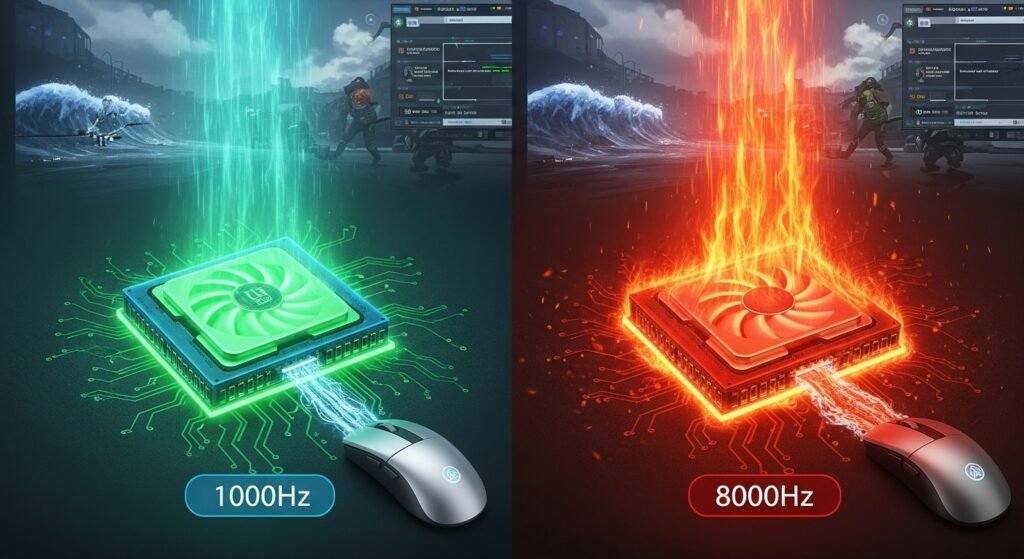
The debate isn’t just about whether you can feel the benefits; it’s also about whether you can suffer the consequences. Pushing your polling rate to its maximum setting isn’t a “free” upgrade. It comes with a hidden performance cost that can, in some cases, make your gaming experience worse.
What is CPU Overhead? (And Why Your Mouse Is Taxing Your PC)
Every single report your mouse sends has to be processed by your computer’s central processing unit (CPU). When your mouse is sending 1000 reports per second, this is a negligible task for any modern PC. But when you crank that up to 4000Hz or 8000Hz, you are asking the CPU to process 4x or 8x the amount of data from the mouse alone.
This extra work is called CPU overhead. While it might not be a big deal when you’re just browsing the web, it becomes a significant factor when you’re playing a demanding First-Person Shooter (FPS). Your CPU is already working hard to run the game, and adding thousands of extra mouse reports per second can become a real burden.
The Risk of Micro-stutters: When Your PC Can’t Keep Up
When your CPU struggles to handle both the game and the constant stream of data from your mouse, you can create a performance bottleneck. This doesn’t always result in a lower average frame rate, but it can cause a far more annoying problem: micro-stutters.
These are tiny, split-second freezes or hitches in your gameplay. Your game might be running at 200 FPS, but it feels choppy and inconsistent. This is because the CPU is occasionally struggling to keep up with the 8000Hz report rate, causing a momentary jitter in game performance. In this scenario, your expensive, high-performance mouse is actively harming your game’s stability.
Case Study: How I “Upgraded” to 4000Hz and Made My Game Unplayable
When I first got a mouse capable of a 4000Hz polling rate, I was excited. I immediately cranked it to the max, expecting a huge boost in responsiveness in my favorite shooter. Instead, the opposite happened. My aim felt floaty and inconsistent, and I noticed tiny, infuriating stutters every time I made a fast flick.
I thought my mouse was defective. After hours of troubleshooting, I finally lowered the polling rate back down to 1000Hz as a test. Instantly, the problems vanished. My game was smooth again, and my aim felt crisp and reliable. My mid-range CPU simply couldn’t handle the extra CPU usage from the 4000Hz setting while also running a demanding game. It was a classic case of a technical “upgrade” leading to a real-world downgrade.
The Synergy Rule: Matching Your Polling Rate to Your Monitor
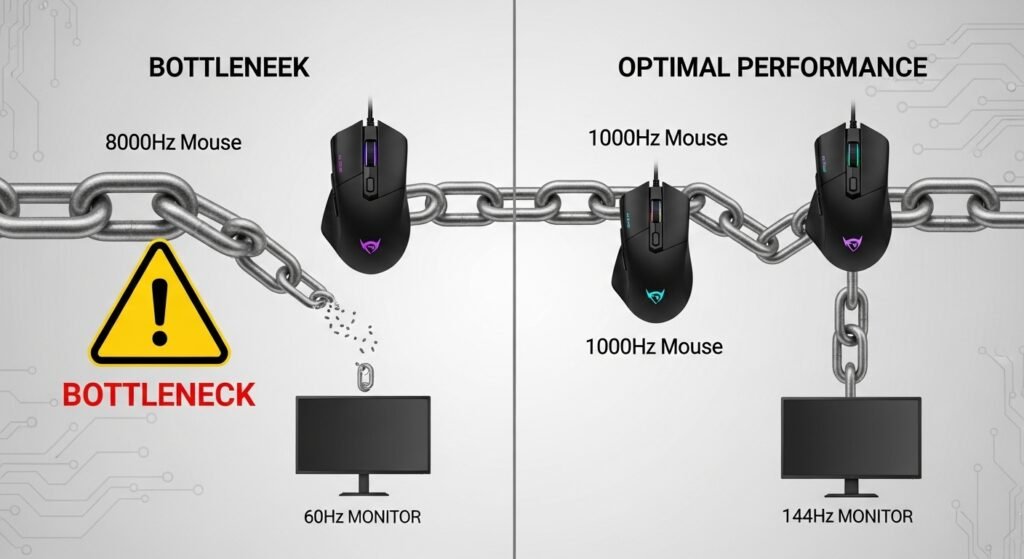
Your gaming mouse does not exist in a vacuum. It is part of a larger system, and its most important partner is your monitor. Think of your gaming setup as a chain: its performance is only as strong as its weakest link. For a high polling rate to provide any real-world benefit, it needs a high refresh rate monitor that can actually display the extra information it’s sending.
The Golden Ratio: Why Your Polling Rate and Monitor Hz Need to Be in Sync
As we know, the polling rate is how often your mouse sends position updates. Your monitor’s refresh rate (also measured in Monitor Hz) is how often your screen updates the image you see. For your movements to feel perfectly smooth, these two components need to be in synchronization.
Ideally, you want your mouse to provide a fresh, new position report every single time your monitor draws a new frame. If the mouse is reporting too slowly, the monitor will be forced to redraw the same old cursor position, causing visible choppiness. If the mouse is reporting much, much faster than the monitor can update, most of that extra data is simply thrown away.
Why an 8000Hz Mouse is Wasted on a 60Hz Monitor
This is the most extreme, but clearest, example of this performance bottleneck.
- A standard 60Hz monitor refreshes the screen every 16.67ms (1000ms / 60).
- An 8000Hz mouse sends a new position report every 0.125ms.
This means that in the 16.67ms it takes for your 60Hz monitor to show you a single new frame, the 8000Hz mouse has sent it approximately 133 different position updates. The monitor can only display one of them. The other 132 reports are completely wasted, providing zero benefit to you while still taxing your CPU. It’s a massive data traffic jam where only one car gets through.
The Sweet Spot: Aligning Your Peripherals for Optimal Responsiveness
The goal is to find a smart balance that ensures peak responsiveness without creating unnecessary CPU load or wasting data. Here is a simple guide:
- For 60Hz – 144Hz Monitors: A 1000Hz polling rate is the absolute perfect sweet spot. It provides a new data point much faster than your monitor can refresh (1ms vs. 6.9ms for a 144Hz screen), ensuring a fresh position is always ready for every frame draw without overburdening your system.
- For 240Hz – 360Hz+ Monitors: This is where the debate gets interesting. While 1000Hz is still a flawless and stable option, a 2000Hz or 4000Hz polling rate could theoretically provide a slightly more up-to-date cursor position for each frame (a 240Hz monitor refreshes every 4.16ms). This is a marginal gain that might only be relevant to top-tier esports professionals, and it’s still subject to the CPU overhead issue. For nearly everyone, 1000Hz remains the most reliable choice.
The Verdict: Who Actually Needs a Polling Rate Above 1000Hz?
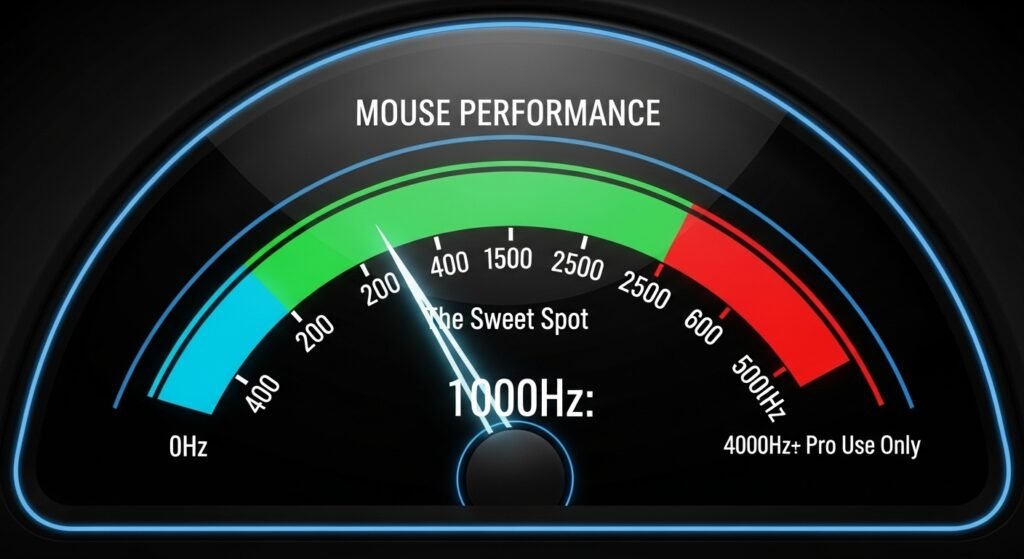
After weighing the minuscule benefits against the very real costs, we can draw a clear conclusion. The push towards ultra-high polling rates is largely a marketing-driven trend, not a gameplay revolution. For the vast majority of players, the answer to “Is a higher polling rate always better?” is a firm no.
For 99% of Gamers: Why 1000Hz is the Perfect Balance of Performance and Stability
For nearly every person playing games today, 1000Hz is the undisputed king. It provides a 1ms response time, which is incredibly fast and well below the threshold of human perception for any further improvements. It delivers elite-level responsiveness and cursor smoothness without the significant trade-off of high CPU overhead or the risk of introducing micro-stutters. It is the gold standard for a reason: it just works, perfectly.
For Esports Pros: The Niche Case for 4000Hz+
So, who are these 4000Hz and 8000Hz mice for? The target audience is the top 0.1% of esports professionals. These are players with lightning-fast reflexes, top-of-the-line PCs (with powerful CPUs), and 360Hz+ monitors. In this hyper-specific environment, the sub-millisecond reduction in latency might provide a tiny, theoretical edge. For these few professionals, where a single frame can be the difference between winning and losing a tournament, that marginal gain is worth the risk of instability. For everyone else, it is an unnecessary complication.
Comparison Table: Polling Rate Recommendations by Gamer Type
| Gamer Type | Recommended Polling Rate | Reason |
| Casual Player (RPGs, Strategy) | 500Hz – 1000Hz | Provides a perfectly smooth experience for non-competitive games. |
| Competitive Gamer (FPS, MOBA) | 1000Hz | The gold standard. The perfect balance of peak performance and system stability. |
| Esports Professional (Top-tier PC) | 1000Hz – 4000Hz | For marginal gains where every microsecond is critical, assuming the system can handle it. |
Frequently Asked Questions (FAQ)
Is polling rate the same as DPI?
Does a higher polling rate use more battery on a wireless mouse?
How do I check and change my mouse’s polling rate?
Can a high polling rate cause jitter or tracking issues?
Is 500Hz good enough for competitive gaming?
Conclusion
In the end, the truth about mouse performance is that a higher polling rate is not always better. The marketing numbers on the box are a poor substitute for real-world stability and a tangible, perceptible benefit. While the jump to 1000Hz was a genuine revolution in mouse performance, the subsequent leaps to 4000Hz and 8000Hz are a clear case of diminishing returns, offering a minuscule advantage in exchange for a very real risk of system instability.
For the overwhelming majority of gamers, 1000Hz remains the undisputed sweet spot. It delivers flawless, high-speed responsiveness that is more than enough for even the highest levels of competitive play, all without taxing your PC. Instead of chasing a bigger number, trust the proven standard. Your focus should be on your aim, your strategy, and your consistency—not on a technical specification whose benefits are often just a placebo.
Now, I want to hear from you: Have you tried a mouse with a polling rate above 1000Hz? Did you feel a real difference, or did you switch back? Share your experience in the comments below!

Hello, I’m John Harbour, a software developer passionate about creating innovative and accessible AI tools. As the creator of cps-checker.com, I enjoy building useful software and writing blogs to help people get the most out of my creations.

